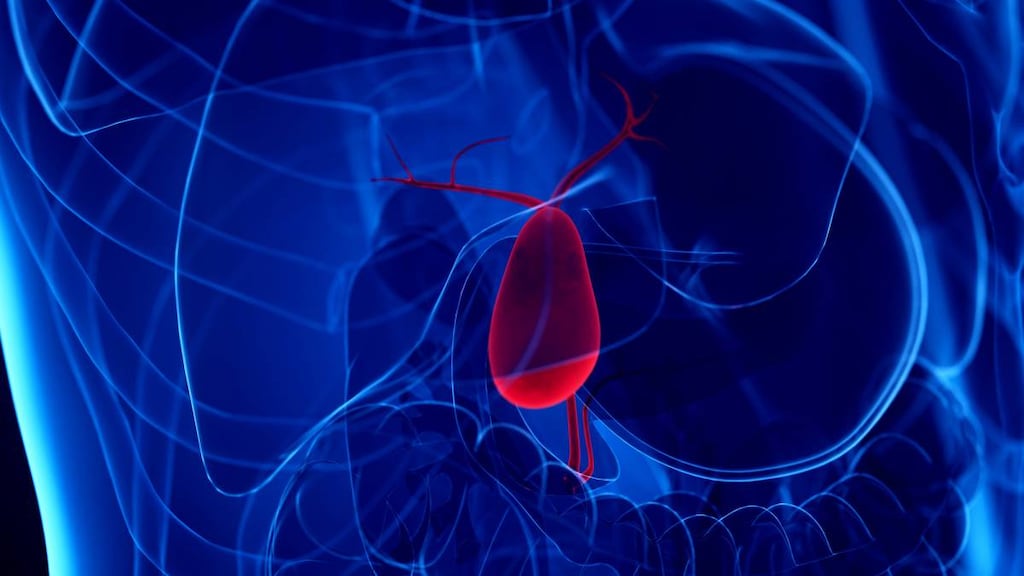
What is cholelithiasis with acute cholecystitis?
People who have cholelithiasis with acute cholecystitis have both gallstones and an inflamed gallbladder.
Cholelithiasis is the medical term for gallstone disease and acute cholecystitis is the term used to describe inflammation in the gallbladder.
What causes cholelithiasis with acute cholecystitis?
Our gall bladder is a pear-shaped organ that sits in the upper right-hand side of our abdomen. It stores bile, which is a combination of water, fats, bile salts, proteins, cholesterol, and bilirubin (a breakdown product of red blood cells), and releases it into our small intestine, where it helps with digesting food.
Gallstones are solid particles that form from mainly either bile cholesterol (called cholesterol stones) or bilirubin (called pigment stones) in the gallbladder. Cholesterol stones are usually yellow-green in color and account for about 80 percent of all gallstones. Pigment stones are small and dark. Gallstones can vary in size from as tiny as a grain of sand to as large as a golf ball, and numbers of gallstones can range from just one up to 100. Cholelithiasis is the medical term for gallstones.
If gallstones lodge in any of the ducts that carry bile from the liver to the small intestine, they can block the flow of bile and cause inflammation of the gallbladder, the ducts, or rarely, the liver. If gallstones block the opening to the pancreatic duct, digestive enzymes can become trapped in the pancreas and cause an extremely painful inflammation called gallstone pancreatitis. Blocking of the cystic duct leads to inflammation in the gallbladder which is called cholecystitis.
People more at risk of developing gallstones and therefore cholelithiasis with acute cholecystitis include those who:
- Are aged over 40 years
- Are female
- Are taking somatostatin analog therapy
- Are dependent on total parenteral nutrition (TPN)
- Have a family history of gallstones (the prevalence of gallstone disease is almost 100% in some Native American tribes)
- Have been fasting for prolonged periods of time
- Have experienced rapid weight loss
- Have had multiple pregnancies
- With a previous ileal resection
- Eat a Western diet
What are the symptoms of cholelithiasis with acute cholecystitis?
Symptoms classically occur 30 minutes to 2 hours following a meal that is typically but not necessarily high in fat content, and may include:
- Abdominal pain in the upper right-hand side of the abdomen
- Pain may also be felt in the shoulder, back, or chest
- Loss of appetite
- Nausea
- Vomiting
- Sometimes jaundice (yellowing of the skin or eyes)
- Sometimes a fever greater than 101.5°F (38.8°C)
In people with acute cholecystitis, pain persists for greater than six hours.
How is cholelithiasis with acute cholecystitis diagnosed?
See your doctor if you have any unexplained, persistent abdominal pain. Your doctor will ask you about your symptoms and perform a physical examination and laboratory testing. The diagnosis is usually confirmed by an ultrasound of the gallbladder.
How is cholelithiasis with acute cholecystitis treated?
90% of people with gallstones never have any symptoms, and treatment is not usually necessary.
Extracorporeal shock-wave lithotripsy (ECSWL) is a nonsurgical treatment for gallstones for people who meet certain criteria. ECSWL sends shock waves through the body which break up or fragment gallstones.
For most people, surgical removal of the gallbladder (called a cholecystectomy) is the main treatment option since gallstones frequently recur. Once the gallbladder is removed, bile flows directly from your liver into your small intestine, rather than being stored in your gallbladder. Sometimes antibiotics or an ERCP (endoscopic retrograde cholangiopancreatography) is needed to remove gallstones from the bile and other ducts.
Ursodiol or chenodiol are two chemicals that have been shown to dissolve some gallstones by thinning the bile, and they may be considered for people who are ineligible for surgery. However, they are not very effective, often take around 2 years to work, and gallstones commonly recur.
Gallbladder removal does not affect your ability to digest food and people can live a normal life without their gallbladder.




